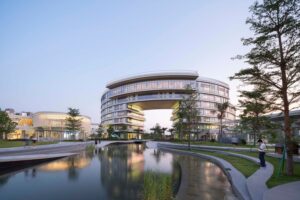The innovative new campus combines the university’s programmatic aspirations to support the symbiotic growth of its academic and research programs with the site’s natural beauty and surrounding new innovation district, all the while supporting carbon neutrality readiness and zero water waste.
The master plan creates an iconic and memorable setting for HKUST(GZ). This first phase of the project encompasses nearly 6 million square feet (about 550,000 square meters) for over 4,000 graduate students and 400 faculty. When fully realized, the campus will accommodate more than 10,000 students and faculty, fostering a true mixed-use community by integrating teaching and learning facilities with housing, neighborhood and campus retail, student life programs, administration, hotel, office and incubator spaces, and athletics facilities. The campus is organized into distinct neighborhoods, with programs and architecture that define spaces and places of varying character.
these specialized facilities are located around a dynamic, central space to foster interdisciplinary collaboration and engender a strong community. This teaching and learning hub is the heart of HKUST(GZ), around which the living learning and research campus will be centered. Eight research and lab buildings, connected by shaded, linear arcades, form a primary, grand urban space that is the nexus of expanding development on east-west and north-south axes. These connect multiple campus programs and provide primary links to the city and the river.
Rather than following a traditional academic structure for the new campus based on schools and disciplines, HKUST(GZ) is centered on a “project-based learning” model which encourages multi-disciplinary interactions. Four key “Hubs” have been established, Function, System, Information & Society. Each structure is supported by “Research Thrusts” which may evolve over time. A full range of teaching spaces, including seminar classrooms, labs, large lecture halls, maker spaces, and collaborative workspaces, are integrated with the research environment.
HKUST(GZ) is a leading example of sustainable development in China, with a 54% reduction of carbon emissions from day one and a goal of achieving carbon neutrality before 2060. The plan features environmental and resilient design measures attuned to Guangzhou’s hot, humid climate along the rapidly urbanizing coast of Southern China and to the flooding, seismic, and climate change risks of the area. The campus’ key driving principles are: Zero Impact, Resilience, Futureproofing, Social Wellbeing, Regenerative Systems, and Living Lab. The master plan employs strategies to address these principles through five focus areas (Energy, Water, Resources, Mobility and Comfort) with specific targets identified.








